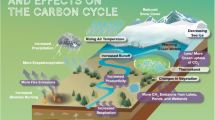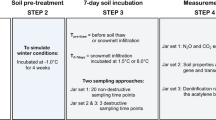Abstract
A potential effect of climatic change was simulated by manipulating the water table height within intact peat monoliths. The treatment decreased methane flux (maximum −80%) and increased both carbon dioxide flux (maximum 146%) and nitrous oxide flux maximum 936%). Returning the water table height to its original level caused both nitrous oxide and carbon dioxide flux to rapidly return to control levels. However, methane flux remained at its experimentally induced low levels.
Similar content being viewed by others
References
Braekke FH (1981) Hydrochemistry of high altitude catchments in southern Norway. 3. Dynamics in waterflow and in release-fixation of sulphate nitrate and hydronium. Norsk Institutt. for Skogforskning 36: 1–21
Bremmer JM & Blackmer AM (1978) Nitrous oxide; emission from soils during nitrification of fertiliser nitrogen. Science 199: 295–296
Cannel MGR & Hooper MD (1990) The greenhouse effect and terrestrial ecosystems of the UK. Institute of Terrestrial Ecology Research Publication No. 4, HMSO, London
Cicerone RJ & Ormeland RS (1988) Biogeochemical aspects of atmospheric methane. Global Biogeochem. Cycles 2: 299–327
Clymo RS (1983) Peat. In: Goodall DW (Ed) Ecosystems of the World 4A; Mires: Swamp, Bog, Fen, and Moor (pp 159–224). Elsevier, Amsterdam
Davidson EA (1991) Fluxes of nitrous oxide and nitric oxide from terrestrial ecosystems. In: Rogers JE & Whitman WB (Eds) Microbial Production and Consumption of Greenhouse Gases (pp 219–235). American Society for Microbiology, Washington DC
Freeman C, Hawkins J, Lock MA & Reynolds B (in press) A laboratory perfusion system for the study of biogeochemical responses of wetlands to climatic change. Proceedings of an International Conference on Land-Water Interactions, New Delhi, India
Gafni A & Brooks KN (1990) Hydraulic characteristics of four peatlands in Minnesota. Can. J. Soil Sci. 70: 239–253
Gorham E (1991) Northern peatlands; role in the carbon cycle and probable responses to climatic warming. Ecol. Applications 1: 182–195
Hameed S & Cess RD (1983) Impacts of global warming on biospheric sources of methane and its climatic consequences. Tellus 35B: 1–7
Harriss RC & Frolking SE (1992) The sensitivity of methane emissions from northern wetlands to global warming. In: Firth P & Fisher SG (Eds) Global Climate Change and Freshwater Ecosystems (pp 48–67). Springer Verlag, New York
Harriss RC, Sebacher DI & Day FP (1982) Methane flux in the Great Dismal Swamp. Nature 297: 673–674
Hemond H (1983) The nitrogen budget of Thoreaus bog. Ecology 64: 99–109
IPCC (1992) Climate change: The IPCC scientific assessment. Houghton JT, Jenkins GJ & Ephraums JJ (Eds). Cambridge University Press, Cambridge, UK, 365 pp
Lashof DA (1989) The dynamic greenhouse: Feedback processes that may influence future concentrations of atmospheric gases and climatic change. Clim. Change 14: 213–242
Mathur SP & Lavesque M (1985) Negative effect of depth on saturated hydraulic conductivity of histosols. Soil Sci. 140: 462–466
Manabe S & Weatherald RT (1986) Reduction in summer soil wetness induced by an increase in atmospheric carbon dioxide. Science 232: 626–628
Mitchell JFB & Warrilow DA (1987) Summer dryness in northern mid-latitudes due to increased CO2. Nature 330: 238–240
Moore TR & Knowles R (1989) The influence of watertable levels on methane and carbon dioxide emissions from peatland soils. Can. J. Soil Sci. 69: 33–38
Ormeland RS (1988) Biogeochemistry of methanogenic bacteria. In: Zhender AJB (Ed) Biology of Anaerobic Micro-Organisms (pp 641–705). J Wiley and Sons, New York
Ponnamperuma FM (1972) The chemistry of submerged soils. Advan. Agron. 24: 29–96
Pulliam WM & Meyer J (1992) Methane emissions from floodplain swamps of the Ogeechee river: Long term patterns and effects of climate change. Biogeochem. 15: 151–174
Rodhe H (1990) A comparison of the contribution of various gases to the greenhouse effect. Science 248: 1217–1219
Sexton AJ, Parkin TB & Tiedje JM (1985) Temporal response of soil denitrification rates to rainfall and irrigation. Soil Soc. Am. J. 49: 99–103
Silvola U (1986) Carbon dioxide dynamics in mires reclaimed for forestry in eastern Finland. Annales Botanica Fennica 23: 59–67
Terry RE, Tate RL & Duxbury JM (1981) The effect of flooding on nitrous oxide emissions from an organic soil. Soil Sci. 132: 228–232
Williams BK & Wheatley RE (1988) Nitrogen mineralisation and water-table height in oligotrophic deep peat. Biol. Fertil. Soil 6: 141–147
Urban NR, Eisenreich SJ & Bayley SE (1988) The relative importance of denitrification and nitrate assimilation in mid-continental bogs. Limnol. Oceanogr. 33: 1611–1617
Yavitt JB, Lang GE & Weider RK (1987) Control of carbon mineralisation to CH4 and COn in Sphagnum derived peat from Big Run Bog, West Virginia. Biogeochem. 4: 141–157
Author information
Authors and Affiliations
Rights and permissions
About this article
Cite this article
Freeman, C., Lock, M.A. & Reynolds, B. Fluxes of CO2, CH4 and N2O from a Welsh peatland following simulation of water table draw-down: Potential feedback to climatic change. Biogeochemistry 19, 51–60 (1992). https://doi.org/10.1007/BF00000574
Received:
Accepted:
Issue Date:
DOI: https://doi.org/10.1007/BF00000574




